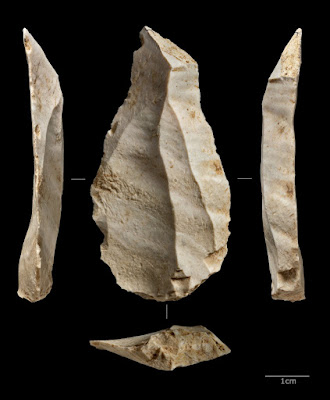https://phys.org/news/2020-03-neanderthals-marine-resource-exploitation.html
Pieces of clam Ruditapes decussatus, found in the site. Credit: Mariana Nabais © João Zilhão
The journal Science has published a study led by the ICREA researcher João Zilhão from the University of Barcelona on the excavation in Cueva de Figueira Brava, Portugal, which was used as shelter by Neanderthal populations about between 86,000 and 106,000 years ago. The study reveals fishing and shellfish gathering contributed significantly to the subsistence economy of the inhabitants of Figueira Brava. The relevance of this discovery lies in the fact that so far, there was little evidence of these practices as being common among Neanderthals.
Regarding the consequences of this study, João Zilhão notes that "an influent model on our origins suggests the common consumption of water resources, rich in Omega3 and other fatty acids that favour the development of brain tissues, would have increased the cognitive skills of modern anatomy humans. That is, those humans who, in Africa, were contemporaries of Neanderthals and are usually regarded as the only ancestors of the current Homo sapiens." But the results of the excavation of Figueira Brava reveal that if this common consumption of marine resources played an important role in the development of cognitive skills, it did so for all humanity, including Neanderthals, and not only the African population that spread later."
Zilhão, a member of the Prehistoric Studies and Research Seminar (SERP-UB), cites "proof that accumulated over the last decade to show Neanderthals had a symbolic material culture." Two years ago, in 2018, the journals Science and Science Advances published two studies co-led by João Zilhão reporting that over 65,000 years ago, Neanderthals made cave paintings in at least three caves in the Iberian Peninsula: La Pasiega, Maltravieso and Ardales (Science).
screen shot of vid.
Cracked-open and burnt fragments of Cancer pagurus pincer? Credit: José Paulo Ruas © João Zilhão
Fifty percent of the diet of the inhabitants in Figueira Brava consisted of coastal resources: molluscs (limpet, mussel and clams); crustaceans (brown crab and spider crab); fish (shark, eel, sea bream, mullet), birds (mallard, common scoter, goose, cormorant, gannet, shag, auk, egret, loon), and mammals (dolphin, seal). They additionally hunted deer, goats, horses, aurochs and other small prey such as tortoises. Among the other carbonised plants were olive trees, vines, fig trees and other Mediterranean climate species, among which the most abundant was the stone pine, burned for heat and cooking. Pine forests were exploited as fruit tree gardens: Mature pines, albeit closed, were taken from the branches and stored in the cave, where the fire could open them.

Marine ressources from Figueira Brava. A. limpets, B. clams, C. crab, D. dolphin vertebrae, E. shark vertebrae. Credit: A-C M. Nabais, D Antunes et al. 2000, E. J. P. Ruas
The study also provides other results suggesting the bias inherent in the concept of Neanderthals as cold and tundra peoples, experts on hunting mammoths, rhinos, buffalo and reindeer. "Most Neanderthals would have lived in southern regions, specially in Italy and in the Iberian Peninsula, and their lifestyle would have been very similar to those in Figueira Brava," notes Zilhão.
View on the Figueira Brava cave with its three entrances. Credit: João Zilhão
Another important finding in the study is the familiarity of humans with the sea and its resources as something older and wider than previously thought. "This could probably help explain how, between 45,000 and 50,000 years ago, humans could cross the Timor Sea to colonize Australia and New Guinea, and then, about 30,000 years ago, the closest islands to the western Pacific," says Zilhão.





No comments:
Post a Comment
Stick to the subject, NO religion, or Party politics